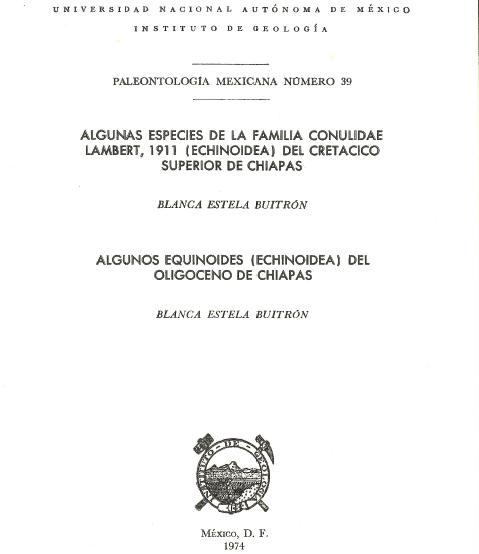Some Echinoids (Echinoidea) from the Oligocene of Chiapas
Main Article Content
Abstract
Four species of echinoids are described, three of which (Oligopygus wheterbyi de Loriol, Clypeaster rogersi (Morton), Echinolampas aldrichi Twitchell) are recognized for the first time in Mexico. The age of the fauna is Oligocene and presents phylogenetic relations with Tertiary faunas of the Caribbean region, Central America, and eastern United States of America.
Article Details

This work is licensed under a Creative Commons Attribution-NonCommercial-NoDerivatives 4.0 International License.
References
AGASSIZ, L. y DESOR, E. (1846-1847). Catalogue raison é des familles, des genres, et des especies de la classe des echinodernes, Ann. Sci. nat. (zool), 3d ser., v. 6, p. 305-374; v. 7 p. 129-168; v. 8, p. 5-35, 355-381.
BOESE, E. (1905). Reseña acerca de la Geología de Chiapas y Tabasco. Bol, Inst, Geol. México, no. 20, 113, p. 8 lám,
y CAVINS, O. A. (1927). The Cretaceous and Tertiary of Southern Texas and Northern Mexico. Univ. Texas Bull. 2748, p. 7-142.
BRONN, H. G. (1848). Index palaeontologicus. 2 v., 2361 p., Stuttgart.
BOYLE, B. (1893). A catalogue and bibliography of North American Mesozoic Envertebrata. United States Geol. Survey Bull. 102, 315 p.
BUITRÓN, B. E. (1974). Distribución de los equinoides terciarios en la Planicie Costera del Golfo de México, en América Central, en el Norte de América del Sur y en las Antillas. Bol. Soc. Geol. Mexicana (en prensa).
CASO, M. E. (1957). El género Clypeaster Lamark, 1801 en el Terciario de México. An. Inst. Biol. t. 27, n. 2, p. 487-528.
CLARK, W. B. (1891). A revision of the Cretaceous Echinoidea of North America. Johns Hopkins Univ. Circ. v. 10, no. 87, p. 75-77.
y TWITCHELL, N. (1915). The Mesozoic and Cenozoic Echinodermata of United States. United States Geol. Survey Mem. 54, 341 p., 107 lám.
CONRAD, T. A. (1866). Check list of the Invertebrata fossils of North America; Eocene and Oligocene, Smithsonian Misc. Coll., v. 7 (200) 41 p.
COOKE, C. W. (1926). The Cenozoic formations. Geol. Sur Alabama, Spec. Rept. v. 14, p. 251-297, lám. 93-97.
(1942). Cenozoic irregular echinoids of eastern United States. Jour. Paleontology, v. 16, n. 1, 62 p., 8 lám,
y MOSSOM, D. S. (1929). Geology of Florida. Geol. Sur. Ann. Rept., v. 20, p. 29-228, 29 lám.
COTTEAU, G. H. (1897). Descripción de los equinoides fósiles de la Isla de Cuba, adicionada por D. Justo Egozcue y Cía. Bol. Comisión del Mapa Geológico de España, t. 2, 2a. ser., 98 p., 29 lám.
DICKERSON, R. E. y KEW, W. S. W. (1917). The fauna of a Medial Tertiary formation and the associated horizons of northeastern Mexico. California Acad, Sci. Proc. ser. 4, v. 7, n. 5, p. 125-156, lám. 17-26.
DUMBLE, E. T. (1918). Geology of the northern and of the Tampico Embayment area. California Acad. Sci., Proc. 4, ser., v. 8, p. 113-156, lám. 3-6.
DURHAM, J. W. (1957). Amber through the ages. Pacific Discovery v. 10, n. 2, p. 8-14.
y HURD, P. D. (1957). Fossiliferous Amber of Chiapas, México. Bull. Geol. Soc. America, v. 68, n. 12, pt. 2, p. 1824.
HURD, P. D. Jr. et al (1962). The Fossiliferous amber of Chiapas, Mexico. Ciencia (México), 21 (3) p. 107-118, 2 lám.
ISRAELSKY, M. C. (1924). Notes on some Echinoids from the San Rafael and Tuxpan beds of the Tampico region, México. Proc. California Acad. Sci., Ser. 4, v. 13, n. 8, p. 137-145, 3 lám.
JACKSON, R. (1918). Fossil Echini of the Panamá Canal Zone and Costa Rica. United States Nat. Mus. Bull. 103, p. 103-116, lám. 46-52.
(1922). Fossil Echini of the West Indies. Carnegie lnst. Washington, Publ. 305, p. 103, lám. 18.
LAMDERT, J. (1927). Notes sur Quelques Echinides recueillis par Mr. Walther Staub dans le Neogene de l’est du Mexique. Eclogae Geologica Helvetia, v. 21, n. 1, p. 272-283, 6 fig., 1 lám.
LÓPEZ RAMOS, E. (1972). Carta Geológica del Estado de Chiapas. Instituto de Geología de la UNAM (inédita).
LORIOL, P. De (1887). Notes pour servir a l’etude des echinodernes. Recueil Zool. Suisse, v. 4, p. 365-407, lám. 15-18.
MORTON, S. G. (1834). Synopsis of the Organic Remains of the Cretaceous Group of the United States. Philadelphia, 88 p., 19 lám,
(1842). Tabular view of the organic remains hitherto discovered in the Cretaceous strata of the United States. Acad. Nat. Sci. Philadelphia Jour. 1st. Ser., v. 8, p. 216-227.
MUELLERRIED, F. K. (1951). Algunos fósiles marinos del Terciario Inferior y Medio de Palenque, Chiapas. Soc. Mexicana, Hist. Nat. Rev. v. 12, n. 1-4, p. 209-227.
(1957). La Geología de Chiapas. Geol, Const. Edo. de Chiapas, 180 p.
MUIR, J. M. (1936). Geology of the Tampico Region. Tulsa, Oklah, 280 p., 15 lám, 40 fig.
SAPPER, C. (1894). Informe sobre la Geografía Física y la Geología de los Estados de Chiapas y Tabasco. Bol. Agr. Min. año III (1), p. 187-211.
(1899). Ueber Gebirgsbau und Boden des Moerdlichen Mittelamerika-Peterm. Mitt., Erg. heft 127.
STEFANINI, C. (1911a). Sugli echini terziari dell'America del Nord. Soc. Geol. Italiana Boll., v. 30, p. 677-714, lám. 22.
(1911b). Note Echinologiche. Revista 1taliana di Paleontologia, v. 17, pt. 4, 16 p., lám. 5.
WAGNER, C. D. y DURHAM, J. W. (1966). Treatise on Invertebrate Paleontology. Moore, R. C. Edit., Echinodermata 3, Part. u, p. 440-450.
WEISBORD, N. E. (1934). Some Cretaceous and Tertiary Echinoids from Cuba. Bull. Amer. Paleont. v. 20, n. 70C, p. 165-268, lám. 20-28.
